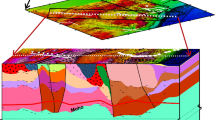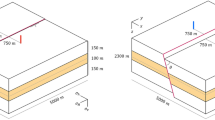Abstract.
The floor of Rabaul caldera experiences complex deformation as revealed both in the geological and historical record, as well as through recent systematic monitoring. The observed deformation pattern has been modelled previously as being caused by tumescent strain above one or more point sources at shallow levels within the caldera block, or as a response of the caldera structure to deeper sources of deformation. Here, two-dimensional finite element modelling is used to re-interpret the pre-1994 eruption deformation data, demonstrating that the observed pattern may have been caused by dykes located in sectors of the ring fault system, as delimited by seismicity. Both a pressurised ring structure and a pair of arcuate sources are modelled. Maximum compressional stress results in a central position within the encompassed block, and a moat-like feature forms offset outwards from the intersection of the azimuth of the modelled deformation sources and the free surface. The modelled deformation generally fits well with the observed movements. That the shallow ring dyke appears not to be complete, existing as two discrete arcuate dykes, helps to explain observed changes in the indicated tilt directions through time. Changing areas of relative down-warping offset outwards from the seismically active ring structure, and north/south-oriented structural up-doming south of Matupit. The distribution of thermal anomalies, and the lack of evidence for shallow central caldera intrusions, can also be explained by this scenario. Associated normal faulting above these dykes, and/or the stress regime generated by simultaneous intrusions into opposite sides of the ring fault, are proposed to explain the apparent inward dip of the intrusions at very shallow levels, leading to the eruptive sites being offset outwards from the seismic zone. A conceptual model is proposed to try to explain the general behaviour of the caldera between 1971 and the eruption of 1994.
Similar content being viewed by others
Author information
Authors and Affiliations
Additional information
Electronic Publication
Rights and permissions
About this article
Cite this article
Saunders, S.J. The shallow plumbing system of Rabaul caldera: a partially intruded ring fault?. Bull Volcanol 63, 406–420 (2001). https://doi.org/10.1007/s004450100159
Received:
Accepted:
Issue Date:
DOI: https://doi.org/10.1007/s004450100159




